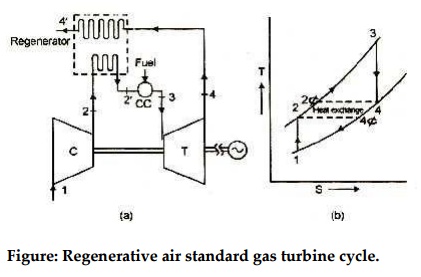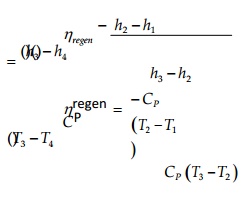Chapter: Mechanical and Electrical : Power Plant Engineering : Diesel,Gas Tubine and Combined Cycle Power Plants
Working of gas turbine cycle with Regenerator

Working
of gas turbine cycle with regenerator.
In earlier discussion it is seen that for the maximization
of specific work output the gas turbine exhaust temperature should be equal to
compressor exhaust temperature. The turbine exhaust temperature is normally
much above the ambient temperature. Thus their exist potential for tapping the
heat energy getting lost to surroundings with exhaust gases. Here it is devised
to use this potential by means of a heat exchanger called regenerator, which
shall preheat the air leaving compressor before entering the combustion
chamber, thereby reducing the amount of fuel to be burnt inside combustion
chamber (combustor).
Regenerative air standard gas turbine cycles shown ahead
in figure (a) has a regenerator (counter flow heat exchanger) through which the
hot turbine exhaust gas and comparatively cooler air coming from compressor
flow in opposite directions. Under ideal conditions, no frictional pressure
drop occurs in either fluid stream while turbine exhaust gas gets cooled from 4
to 4’while compressed air is heated from 2 to 2’. Assuming regenerator
effectiveness as 100% the temperature rise from 2 –2’ andropfromd4 to 4’isshown
on T-S diagram.

Figure: Regenerative air standard gas turbine cycle.

Thus thermodynamically the amount of
heat now added shall be
Q add, regen = m(h3 –h2’)
Whereas without regenerator the heat
added; Qadd = m(h3 –h2)
Here it is obvious that, Qadd, regen
< Qadd’
This
shows an obvious improvement in cycle thermal efficiency as every thing else
remains same. Network produced per unit mass flow is not altered by the use of
regenerator.
Air standard cycle thermal
efficiency,

Related Topics